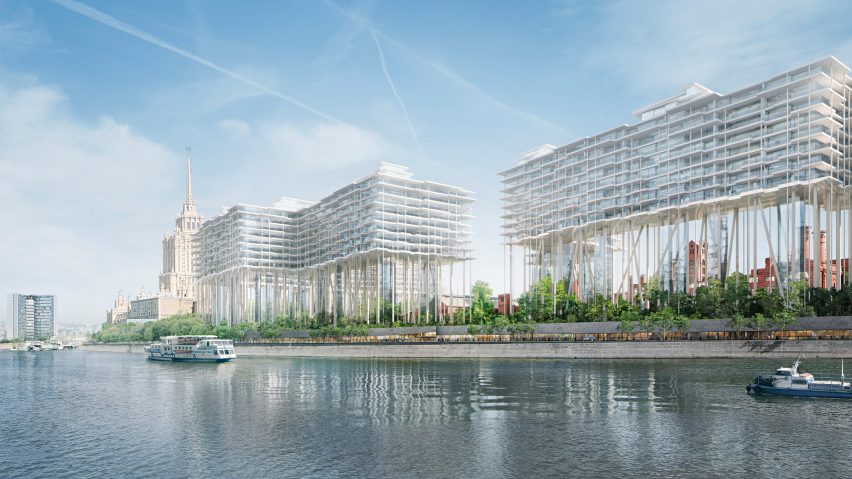Herzog & de Meuron has unveiled plans for two apartments blocks built on stilts, as part of its redevelopment of an abandoned brewery on the banks of the Moscow River.
The Swiss architects plans to restore the Badaevskiy Brewery in the centre of the Russian capital will include building two residential blocks raised 35 metres above the ground.
Dubbed "horizontal skyscrapers" by the practice, the apartment blocks' form results from the protected status of the former brewery and a local building height limit set at 75 metres.
Described by Herzog & de Meuron as "a piece of city lifted up in the air", the new platform-raised structure is designed to be sympathetic to both the modern cluster of skyscrapers across the river and its historic location.
Fully glazed facades will give panoramic views over the river and the city, and each residence will have its own private balcony.
Eight "sky villas" on the uppermost levels will have access to their own rooftop gardens. Three underground levels beneath the complex will house parking.
Along with the residential blocks the surviving clusters of 19th century industrial buildings are set to be renovated and repurposed. A new public park beneath the raised apartments will connect the historic site with the river.
"Moscow is a city with a rich and controversial cultural and political heritage, with architectures reflecting avant-garde as well as conservative trends in the course of history," said Jacques Herzog, co-founder of Herzog & de Meuron.
"Our project for the redevelopment of Badaevskiy factory inserts itself in this very history and tradition of Moscow urbanism – it respects and re-uses existing industrial buildings while adding and overlaying them with radically contemporary structures."
The Basel-based firm has form in transforming former industrial sites. Herzog & de Meuron recently revealed plans to develop a former gasworks complete with a new residential tower, in Stockholm, Sweden.
The design is reminiscent or the Wolkenbügel, or "cloud-irons", which was a conceptual project of horizontal skyscrapers cantilevered from a central pylon designed by Russian avant-garde architect El Lissitzky in the early 1920s.
"We were hesitant to come up with a building typology, which is so remindful of the Wolkenbügel, one of the most heroic icons of the Russian avant-garde," read the architects statement.
"But here it didn't look heroic or monumental. The building does not fly; it rather sits on many slender stilts like an elevated lodge in the forest. The stilts connect the building with the ground and the park like trunks of trees."
The site's original brick buildings, some that date back to 1875 when a factory was founded on the site, will also be restored as part of the development.
A pair of Russian romantic revival arcaded buildings on the eastern side of the plot are due to be turned into a food market, fashion store, co-working space with conference centre and gym.
The cluster of English-style industrial buildings on the western side, including a neo-gothic water tower, silos and cupolas will be transformed into apartments, a traditional banya, or bath house, and an arts centre.
A central building that is missing will be rebuilt in matching brick according to the original designs. It will house a grand hall space and a small local brewery. The area by the river will become a promenade lined with shops and restaurants.
"We found it extraordinary and especially appealing to use the opportunity to push such a radically different urbanistic approach in a city which has traditionally preferred tabula rasa concepts, in the Soviet as well as the post-Soviet periods," continued the architects.
In Berlin, David Chipperfield Architects are masterplanning an £185 million project to restore 19th century brewery damaged in the second world war and add three new volumes to formed a mixed use development, while in London artistic due Gilbert & George are turning an old brewery into a gallery.

